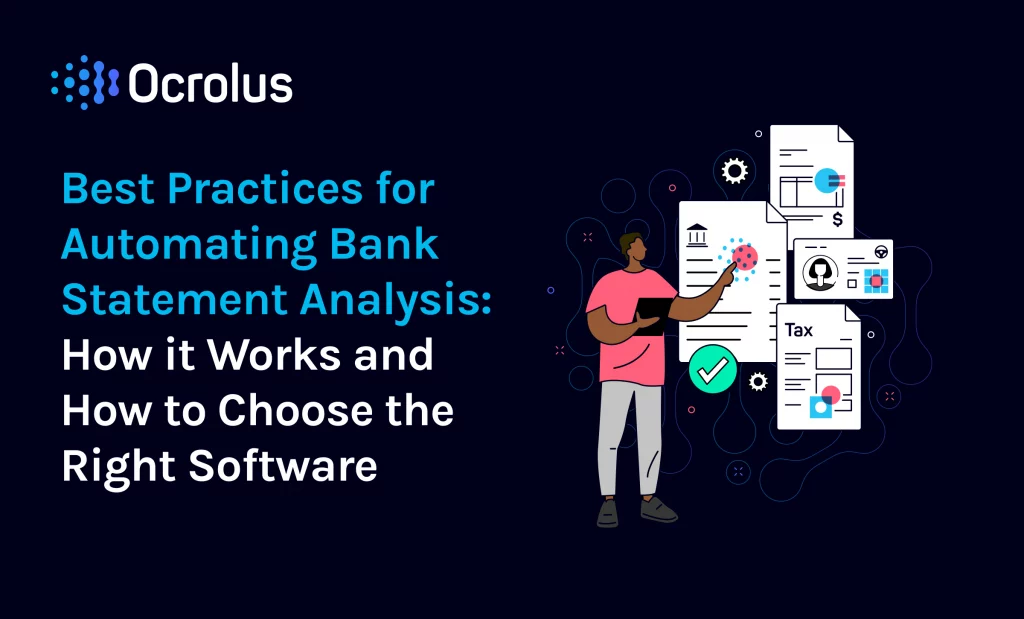Best Practices for Automating Bank Statement Analysis: How it Works and How to Choose the Right Software

Bank statement analysis, a cornerstone of loan application processing, has been a historically time-consuming, manual process. But now, intelligent document processing technology and sophisticated machine learning algorithms enable financial information to be extracted and validated automatically.
Automated document review and processing recognizes and classifies documents with the highest levels of accuracy. AI-powered processing uses best-in-class OCR technologies to capture and digitize bank statements. Results can be indexed and processed quickly – reducing turnaround time from days or hours to minutes.
Academic research underscores the viability of using automation and machine learning to analyze bank statements. Automation of bank statement documents facilitates a faster and more accurate loan approval process. This results in cost reductions, less manual processing, elimination of paper forms, and improved underwriting accuracy.
What is automated bank statement analysis?
Automated bank statement analysis includes the ability to upload, capture, and analyze data extracted from a document.
Leading banks and fintechs use automation as part of loan-approval systems that rely on assessing bank statements and other borrower documentation. A McKinsey report notes that by building data sets that utilize both conventional and new data sources, lenders can generate highly accurate predictions of a customer’s ability to meet their loan obligations.
Lendio, for example, has replaced manual bank statement review with automation. The company, of the leading marketplaces for small business loans in the U.S., now has the ability to automatically review bank statement data provided by borrowers.
Automation technology has enabled Lendio to more efficiently scale and improve its credit risk management underwriting. Automation also has helped Lendio reduce overall loan processing time to under an hour, with better accuracy. In addition to speed and accuracy, automating bank statement analysis makes it easier to identify potentially fraudulent or inaccurate bank statements.
How does bank statement analysis automation work?
Bank statement analysis automatically parses data from PDF files and provides lenders with actionable insights about a borrower’s activity, including recurring transactions, income, and loan payments. Underwriters can use that data to help assess a customer’s ability to repay a loan.
Bank statement automation uses an API to enable document classification. Machine learning models are trained to capture and analyze key data fields and to detect fraud. Classification then relies on AI algorithms to recognize and categorize documents. Once data is captured, it can be structured for automated review or human analysis. By flagging irregularities, bank statement automation ensures that an individual gets to review statements before making a loan decision.
Automatically extracting bank statement data into a structured format reduces the need for manual entry and validation. This feature streamlines a lender’s ability to identify file tampering, incomplete data sets, invalid data, or other anomalies in the information supplied by a borrower. Having clean, normalized bank statement data provides borrower-level insight to help reduce high-risk loans. It also enables financial institutions to aggregate data for insights into borrower cash flows and income trends.

The challenges and benefits of analyzing bank statements
Bank statements can provide an accurate way to demonstrate proof of income and are particularly useful for verifying a self-employed individual’s income and cash flows. Automation reduces manual processing and provides a consistent, universal data format for analyzing and verifying bank statement data.
Key benefits of automating bank statement analysis include:
Challenge: Slow manual process
Benefit: Classify statements quicker and more efficiently
Challenge: Accuracy with human error
Benefit: Capture mission-critical data accurately and at scale
Challenge: Fraud is on the rise
Benefit: Detect suspicious activity, file tampering, and potential fraud faster
Challenge: Volume of borrower data and income information
Benefit: Analyze borrower data thoroughly to gain insights related to cash flow and income
Automated bank statement analysis supports loan underwriting by generating accurate results on every file. Fintechs that don’t automate have a higher risk of human error in the loan review process. In particular, as fraudulent activity becomes more sophisticated, bank statement verification software provides a more accurate and efficient way to detect fraud. The lack of automation also makes compliance more difficult. That is because automation produces a comprehensive audit trail of key data.
Automation is also essential for delivering a fast and frictionless loan review process for borrowers. A recent Oracle report notes that customers in today’s marketplace expect a quick response and fast turnaround of their loan applications.
How to find the right automated bank statement analysis software for your process gaps
Here’s a checklist of some important features to consider when evaluating bank statement analysis software:
- Ability to classify, capture, detect, and analyze data from a bank statement.
- High accuracy.
- Works with different document formats, layouts, and styles.
- Validates the legitimacy and consistency of information and data entries.
- Ability to detect discrepancies or fraudulent activity.
- Option for manual review and adjustment.
- Easy-to-use dashboard and interface.
- Scalability.
- 24/7 support.
The Ocrolus API enables financial institutions to seamlessly classify documents, capture key data fields, detect fraud, and analyze cash flows and income.
In an increasingly competitive lending environment, automated bank statement analysis enables lenders to faster and more accurately evaluate the creditworthiness of all customers and, in particular, non-traditional and self-employed borrowers. At the same time, automation speeds the entire loan application review process and helps lenders reduce risk by making smarter lending decisions.
Learn more about how to integrate automated bank statement analysis into your lending workflow by scheduling your free demo today.


